Crown of Halachah

Dayan Chanoch Ehrentreu's reign of unbending standards and unstinting kindness
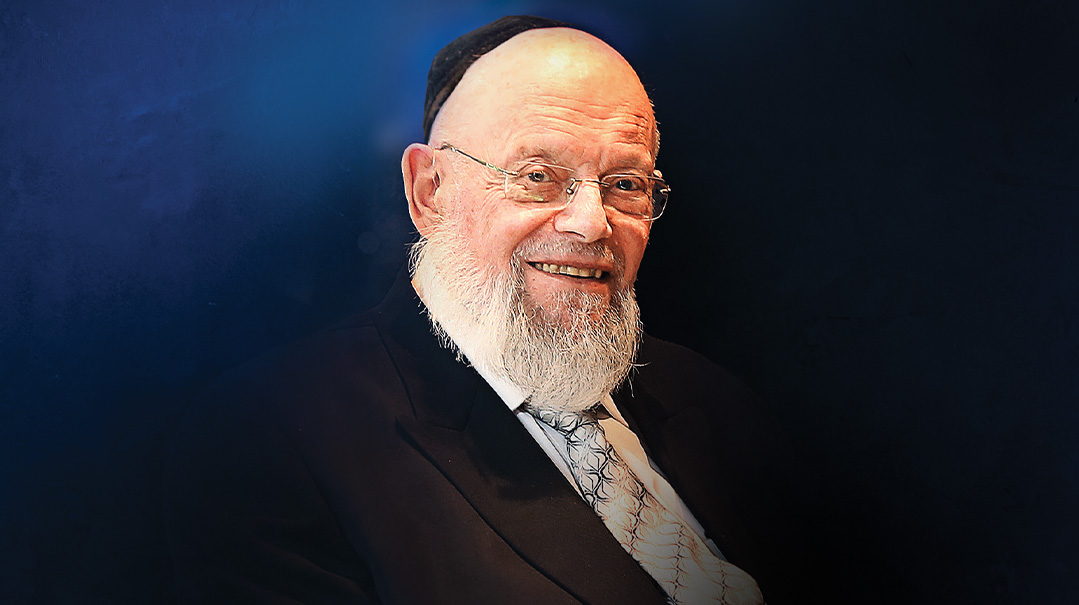
Photos: Tim Spott, Family archives
Dayan Chanoch Ehrentreu carried himself with great dignity, yet he wouldn’t hesitate to roll up his sleeves to bathe an infant after a bris or don sneakers to walk the entire circumference of an eiruv in the process of being built. His psakim were unequivocal and he was outspoken and fearless when necessary as he defended halachah and built Torah infrastructure across Europe. Now, the benevolent reign of unbending standards and unstinting kindness has come to a close
European Jewry lost its general with the passing of Dayan Chanoch HaKohen Ehrentreu last Thursday morning, Rosh Chodesh Kislev.
The Dayan, who was nearly 90 when he passed away, left a legacy of building Torah and serving the community in just about every possible rabbinical role. He was founder and head of the Sunderland kollel for 18 years; av beis din in Manchester, London, and of the European Conference of Rabbis; communal rav; and builder of Torah institutions, often fulfilling those multiple roles at the same time.
And just as he excelled in a combination of rabbinical roles matched by no contemporary rabbinic figure, so did he combine in his person a unique blend of qualities. He was fully at home in yeshivah lomdus, as his crystal clear shiurim in the various kollelim he headed made clear, and was an equally eloquent darshan, who knew how to lace his derashos with stories, meshalim, and personal reminiscences to bring home an inspirational message. To his congregants (and their children) in the Beis Hamedrash Beis Yisroel in Hendon, he was at once the revered rav and the beloved zeide on whose lap children rushed to sit from an early age.
He carried himself with great dignity and was always immaculately dressed. But he wouldn’t hesitate to roll up his sleeves to show a nervous new mother how to bathe her infant after his bris the previous day or to don sneakers to walk the entire circumference of an eiruv in the process of being built, usually leaving the much younger rabbanim accompanying him far behind.
His psakim were clear, without equivocation, whether on a communal level or to an individual, and delivered with the confidence of one thoroughly grounded in his own Torah learning and in the long rabbinical line from which he came. He was outspoken and fearless when he needed to be, yet at the same time, he knew his own limitations. And if a new issue presented itself about which he was not sure, he didn’t hesitate to consult with the posek hador, Rav Yosef Shalom Elyashiv.
That combination of absolute clarity about what he knew and also about what he wasn’t sure about earned him the respect of the world’s leading poskim. An American-born avreich, who was considering taking a rabbinic position in kiruv in London, once found himself in the same car with Rav Elyashiv. He told the posek hador that there was an issue in London that he felt might impede his success if he accepted the position. Rav Elyashiv told him succinctly, “If Dayan Ehrentreu supports it, you can rely on him.”
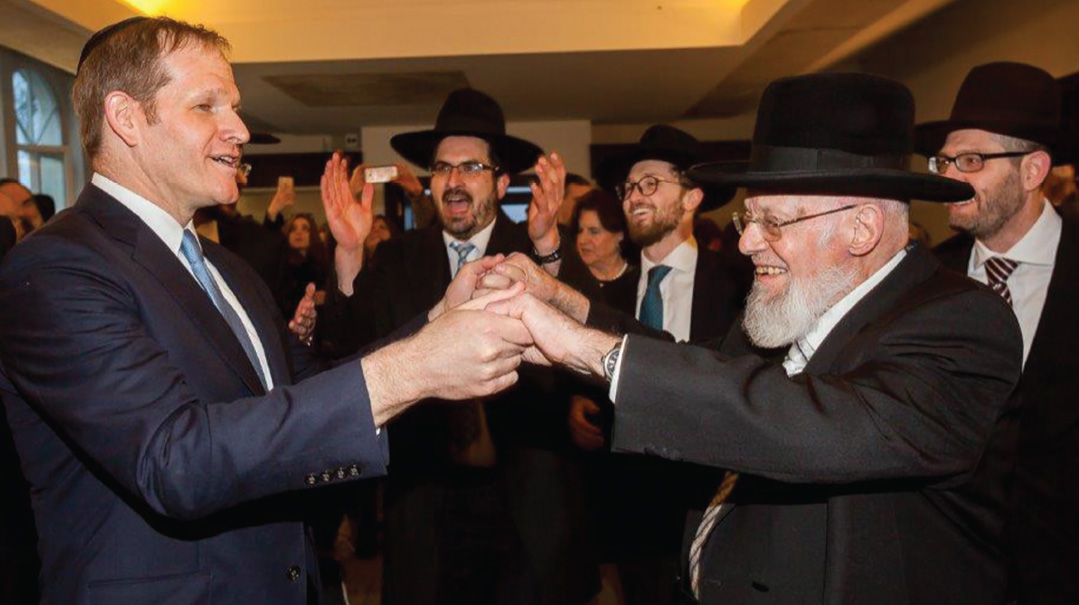
Rabbi Joshua Spinner, director of the Ronald Lauder Foundation in Berlin, in celebration with Dayan Ehrentrau. After his retirement from the London Beis Din, the Dayan served a nasi of the reopened Hildesheimer Rabbinical Academy, bringing his own family history full circle
As firm and clearcut he was in his decision making, he was nevertheless the warmest of people. He had, says Rabbi Dovid Refson, Founder of Neve Yerushalayim, who knew him for 75 years, a phenomenal ayin tov. He genuinely loved people, and rejoiced in their successes. He instinctively judged everyone he met favorably, unless and until they proved unworthy of that judgment. The Canadian-born wife of a friend told me that she noticed that when people spoke of Dayan Ehrentreu, they always smiled at the mention of his name. When she finally had the opportunity to meet him and experienced his beautiful smile, she immediately understood why.
“He packed into a day what you or I could not do in a month,” is a common refrain of those who watched him up close. Yet he gave those who met with him his undivided attention, without conveying any sense of being under pressure.
Apart from his official duties, he took responsibility for Klal Yisrael, as the initiator of many Torah institutions and initiatives. Yet he never lost sight of every single member of the klal, whether religiously observant or not. There was nothing he wouldn’t do for a fellow Jew. The late Rabbi Yehuda Refson boarded with the Ehrentreus as a teenager in Gateshead Boarding School, and later served as av beis din in Leeds. He said of Dayan Ehrentreu, “I know that if I call him and tell him that I’m having an issue in my kehillah, he’ll be on the next plane to Leeds.”
During the time he served as av beis din in Manchester, he heard of a teenage girl in a local hospital who was on the verge of death from anorexia. Despite the fact that he was a Kohein, he went to the hospital to see if he could persuade her to eat. Her doctors had largely given up hope and expressed immense skepticism that he would succeed. But he did. Nor did he leave matters at that one-time success. For the next five months, he visited her daily to feed her.
Saving her life, however, was only the beginning of his involvement. The Dayan arranged foster care for her with an Orthodox family on his block. When she phoned to say that she had met a young man in Israel, Dayan Ehrentreu flew to Israel to meet the young man, now her husband, to determine his suitability. That young girl is herself a grandmother today, and still Dayan Ehrentreu called her every time that he was in Israel.
On another occasion, a Jewish woman in the hospital was shocked when Dayan Ehrentreu turned up at her bedside. He introduced himself, and told her that he would be staying there until she signed a consent form to have her leg amputated, which the doctors insisted was necessary to save her life. The Dayan informed her that the hospital had provided him with a room down the hall, and his rebbetzin would bring him his food. The woman gave her consent to the amputation.
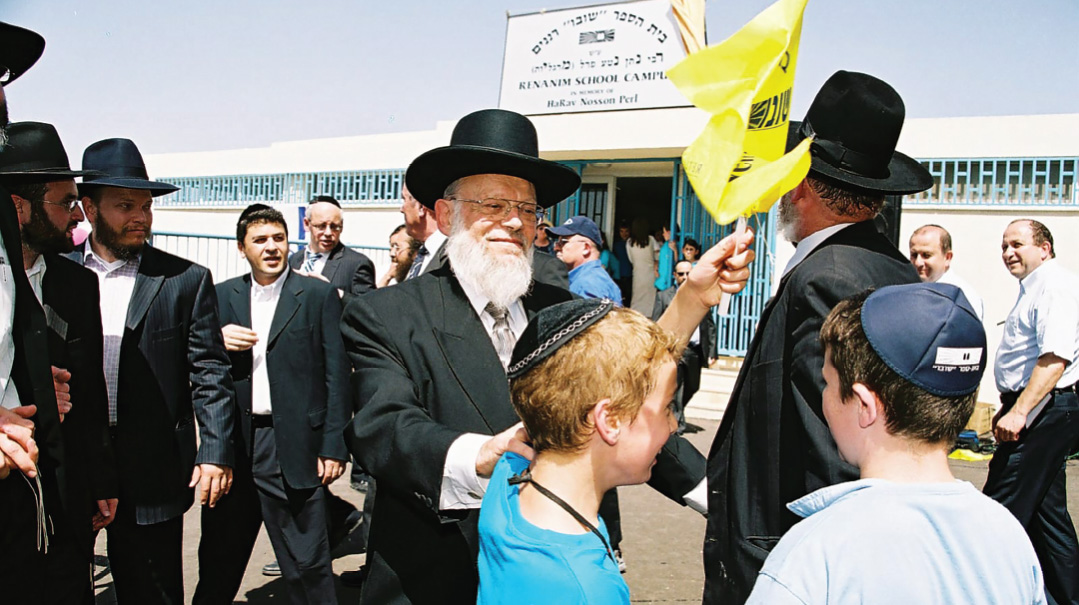
The Dayan in a joyous dance with children from a newly-dedicated Shuvu school. It was part of his long-term commitment to all forms of kiruv wherever it was happening
DAYAN EHRENTREU was born in Frankfurt during Chanukah of 1932. Though only six at the time of Kristallnacht, November 9–10, 1938, he retained vivid memories of “the flames consuming the holy scrolls, which had been removed from the Ark to the courtyard outside the synagogue to be burned.” His father was taken away by the Gestapo to Dachau for two months. As soon as he was released, the family left for England, where they spent the war years in Letchworth, where many London Jews fled during the nightly bombardment of London. The famous Sassoon family had their estate in Letchworth, and Rav Eliyahu Eliezer Dessler was a weekly visitor to learn with Solomon David Sassoon, his prized talmid, in the course of his fundraising rounds for the newly founded Gateshead Kollel. When the young Chanoch Ehrentreu was sent to the Gateshead Boarding School in his mid-teens, he missed his family greatly. It was only Rav Dessler’s solicitude, he remembered later, that made the separation from his family bearable.
His outstanding analytical abilities, phenomenal memory and passion for learning were soon manifest in Gateshead Yeshiva. And while still a bochur, he was invited to learn in the famed Gateshead Kollel.
On Rosh Chodesh Kislev 1955, he married his life partner Rochel (Ruchie) Sternbuch. (The date of his petirah was their 67th anniversary.) Though thoroughly devoted to her husband, Rebbetzin Ehrentreu nevertheless found the time to become a much sought-after Torah lecturer for women and to oversee a number of chesed funds. And together, they formed a powerful team, whose impact was even greater than the sum of their parts.
I had the chance to observe Rebbetzin Ehrentreu’s solicitude for her husband at close range. Prior to a 2018 ceremony honoring Dayan Ehrentreu at the German Foreign Ministry in Berlin, I had a scheduled interview with the Dayan. His rebbetzin adjured me to keep it short, as the Dayan needed to rest before the ceremony. It soon became clear, however, that her warnings were more directed at her husband than at me, as he was in an expansive move and eager to discuss at length his many current projects.
In 1960, Rav Shammai Zahn, the rosh yeshivah of Sunderland Yeshiva, and Rav Avrohom Moshe Babad, the rav of the community, had the idea of establishing a kollel in the town. At the time, the idea of a new kollel was radical. The Gateshead Kollel was the only one in the country, and both within the Kollel and without, it was assumed that it would remain so always. But when Rav Zahn and Rav Babad broached the idea with Rav Ehrentreu, he ran with it, raising the money to start the kollel and assuming full responsibility.
Rabbi Dov Roberts of Gateshead, who was a member of the Sunderland kollel, remembers the “spitz Torah” of the young rosh kollel, but also his attention to every detail connected to the ability of the kollel members to learn — the lighting, the heating, even the well-kept garden around the kollel building. That attention to detail was evident in everything he did over his long public career.
Most of the talmidim in Sunderland Yeshiva in 1960 were originally from Morocco. (Rav Zusha Waltner, one of the first members of the Gateshead Kollel, who founded Sunderland Yeshiva together with Rav Zahn, had moved to Morocco, and directed a steady stream of talmidim to Sunderland.) And at least half the kollel members, some of whom became noted rabbanim, were from Moroccan backgrounds. They were distanced from their families and had to adjust to a different culture, and many of them benefitted from the Rosh Kollel’s giving and nurturing nature.
During his 18 years at the helm of the Sunderland Kollel, Dayan Ehrentreu developed a web of contacts throughout England in the course of his fundraising activities. But as soon as he’d return from fundraising, he would immediately plunge back into whatever sugya the kollel was learning.
He could fully immerse himself in learning and totally shut out every distraction. Once he was learning the Chazon Ish together with Dayan Shmuel Simons of the London Beis Din. At that time, his son, Shlomo Ehrentreu a”h, who was living in Toronto, had been diagnosed with a life-threatening illness. In the course of the learning session, Rebbetzin Ehrentreu entered the room and announced, “Chanoch, Shloimy received his test results.” But the Dayan didn’t respond. He had simply not heard her. She repeated herself three times before she could gain his attention.
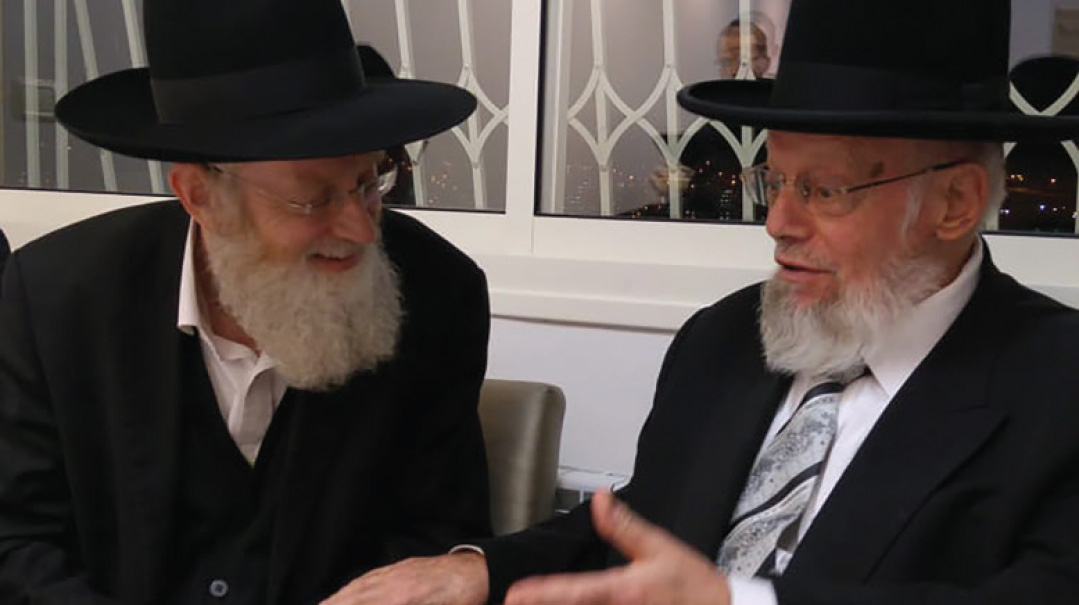
Enjoying a simchah together with his nephew Rav Asher Arielli (Rav Arielli’s mother is a sister of Rebbetzin Ehrentreu)
IN1979, Rav Yitzchok Yaakov Weiss, the av beis din of Manchester, was appointed the Gaavad of the Eidah Hachareidis of Yerushalayim, and Dayan Ehrentreu assumed his position in Manchester, where he remained for six years. One of the Dayan’s lifelong traits was his sense of achrayus. If any operation, such as shechitah, was under his authority and supervision, notes Rabbi Dovid Refson, he would thoroughly investigate the operation, without regard to what had been the practice until then — a decidedly un-British trait, adds Rabbi Refson. That sense of achrayus for everything under his supervision was soon evident in Manchester, and would become even more so in London.
While in Manchester, the Dayan and his rebbetzin created an informal social welfare network, including personally delivering clothes and the money for furniture to less well-to-do kallahs prior to marriage. Mr. Joshua Rowe, who usually hosted the Dayan on his visits back to Manchester after his departure to London, recalls how on his return to Manchester, he would go to visit the families whom he had dealt with previously. He would also be at the local slaughterhouse at five a.m. to assure himself that everything was still as it should be with the local shechitah.
In 1984, Chief Rabbi Immanuel Jakobovits asked Dayan Ehrentreu to become the av beis din of the London Beis Din of the United Synagogue, the ultimate halachic authority for most congregations in the United Kingdom. As his brother-in-law Rav Moshe Sternbuch described in his hesped, Dayan Ehrentreu’s first priority in his new position was to dramatically improve the level of the kashrus certification of the London Beis Din. If that included raising money to expeditiously fire shochtim whose level of religious observance was unacceptable to the Dayan, while providing them with a generous severance package, he would do that. In short order, the reputation of the London Beis Din’s supervision improved worldwide.
Rabbi Rashi Simon was the geirus coordinator for the London Beis Din for two decades, beginning under Dayan Ehrentreu. He remembers how Dayan Ehrentreu used to sit in on the interviews with candidates for geirus in his early years on the job. One such candidate told the Dayan that he simply didn’t have the money to pay for the required tutorials for his family and himself. The Dayan pulled out 75 British pounds from his pocket and handed them to the man, telling him, “This will pay for the next five lessons.”
His standards for geirus, however, were high. A wealthy Jew, who rode about in a chauffeured Rolls Royce, was married to a non-Jewish woman who professed interest in converting. But the couple didn’t want to move into a neighborhood with a Torah infrastructure, and the Dayan told them that she could not be converted. The husband, who had the air of someone used to getting his way, told Rabbi Simon, “I should be angry with Dayan Ehrentreu, but I can’t be. He is such a gentleman.”
Apart from the improved standards of kashrus certification, Dayan Ehrentreu’s greatest impact through the London Beis Din came in the form of the building of an eiruv in Northwest London. At that time, there wasn’t a single communal eiruv in the United Kingdom. Dayan Ehrentreu oversaw the entire London eiruv from beginning to end, and today there are 15 eiruvin in the UK, almost all constructed under the auspices of the London Beis Din. Rabbi Alan Kimche, the long-time rav of Hendon’s Ner Israel shul and a member of the eiruv committee, remembers bringing a complicated sh’eilah concerning the eiruv to Dayan Ehrentreu. The latter took out the Chazon Ish on Eiruvin, and Rabbi Kimche noticed that Dayan Ehrentreu had written extensive marginalia on almost every page.
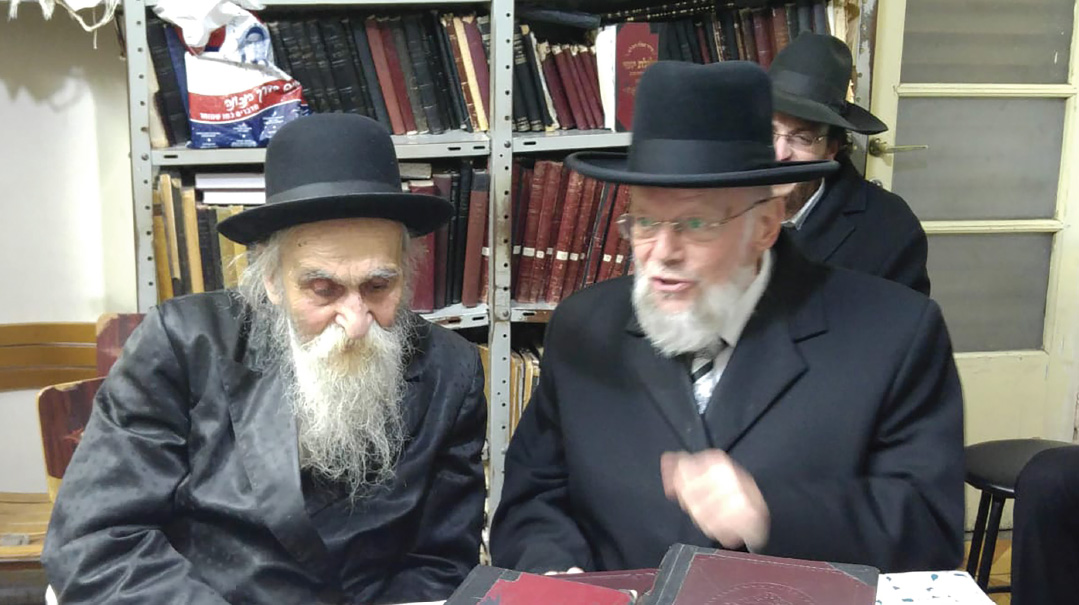
In a conference with his brother-in-law Rav Meshulam Dovid Soloveitchik ztz”l
Even with the full responsibility of the Beis Din on his shoulders, in 1988, Dayan Ehrentreu agreed to become the rav of a new shul in Hendon, London. True to its name, Beis Hamedrash Beis Yisroel was not just a place of prayer but a bastion of Torah learning. Though few of the original shul members had extensive yeshivah backgrounds, many of the children of long-time members have gone on to learn in kollel for many years or marry those who have. The Dayan’s own love of Torah learning transformed these families.
“It was simply contagious,” says Moshe Morris, frequently described as the Dayan’s most ardent chassid. The Dayan gave a weekly Minchas Chinuch shiur, another shiur in Bava Basra, and a number of derashos on Shabbos. And he learned privately with different balabatim. Moshe Morris, for instance, had a two-hour weekly chavrusa with the Dayan in Choshen Mishpat. He frequently had occasion to marvel how the Dayan could arrive back in the country from some far-flung destination past midnight and still be completely fresh for their morning chavrusa.
The Dayan’s infectious love of learning and his refined middos drew the balabatim ever closer. Moshe Morris, who learned in Kol Torah, remembers seeing Rav Shlomo Zalman Auerbach bend down to pick up a tissue a bochur had dropped on the floor. And the Dayan, he says, conveyed that same sense: nothing that needed to be done was beneath a person of his stature.
Rabbi Rashi Simon gives a concrete example. Among his many areas of expertise, the Dayan was also a mohel, and the Simons asked him to be the mohel at their son’s Erev Shabbos bris. Late Friday afternoon, Rebbetzin Simon discovered the infant’s diaper filled with blood from what turned out to be a clotting problem. She phoned the Dayan and the Rebbetzin answered. She immediately ordered a cab and went to fetch the Dayan, who had already gone to shul. From there they proceeded to the Simons’ home, which was at least five miles away.
By the time the Dayan had attended to the infant’s bleeding, there was no possibility of returning to Hendon before Shabbos, and the Ehrentreus joined the Simon family for their Shabbos meal, before setting out on the long walk back home. Before doing so, Dayan Ehrentreu provided Rabbi Simon with a signal to reach him by phone if the bleeding recurred on Shabbos, and assured him that if necessary, he would instruct him what to do. Reflecting on that incident, Rabbi Simon marvels that it never occurred to Dayan Ehrentreu to send someone else in light of the multitude of responsibilities upon him and his stature as the leading rav in the country.
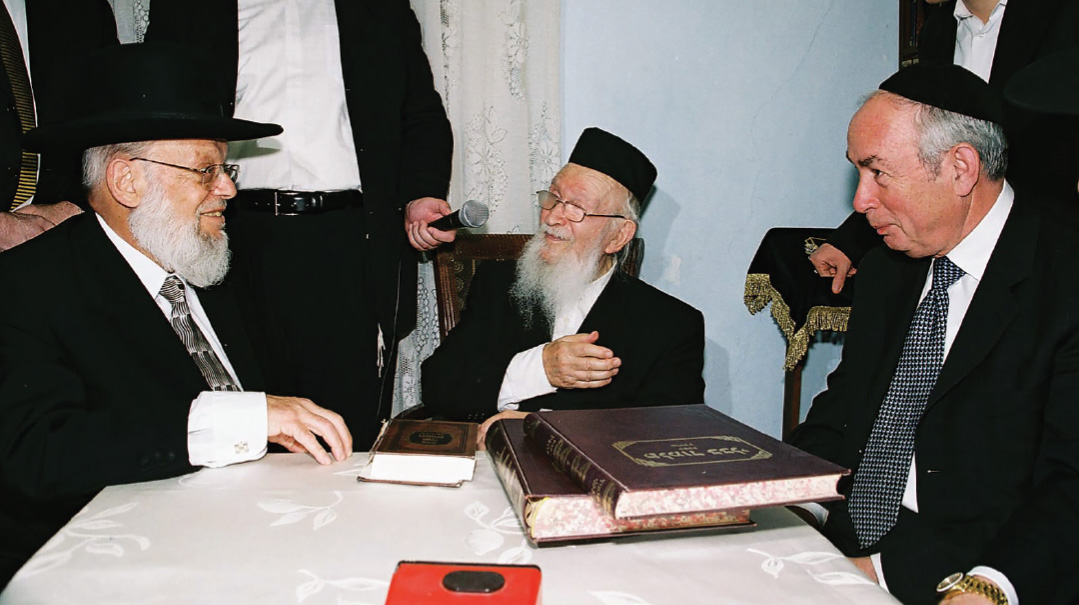
A brachah from Rav Michel Yehudah Lefkowitz ztz”l, together with Reb Leizer Perl, who donated a Shuvu school building in Nof HaGalil (Upper Nazareth). For all his international efforts, a wing of the building has been named in honor of the Dayan
The members of the shul played a key role in the Dayan’s manifold plans for uplifting English and European Torah Jewry. When a member of the beis medrash decided to donate a sefer Torah to a shul in Leipzig, his ancestral home, the Dayan and a group of ten members from the shul joined him for the hachnassas sefer Torah. Prior to the Dayan’s derashah, a group of families in the kehillah, all of them Russian immigrants to Germany, came to speak to the Dayan. They explained to him that there was no local mikveh, and they had to travel three hours each way by train to the nearest mikveh.
The Dayan put aside his prepared derashah, and announced that they would not be returning to London until he had secured the necessary commitments to build a mikveh in Leipzig. Even when informed that it was starting to snow, and that they had to get started for the airport, the Dayan refused to budge. Fortunately, it only took a few minutes for the balabatim present to confer and come up with the necessary pledges to build the mikveh.
Similarly, members of the shul were instrumental in supporting British Friends of Shuvu, the educational network in Israel founded by Rav Avraham Pam for children from Russian-speaking families. Dayan Ehrentreu led the first delegation of the British Friends, including Leizer Perl (who donated a school building in Nof HaGalil) and Manny Weiss, two balabatim who were very close to the Dayan. At the most recent Shuvu dinner in the UK, it was announced that a branch in the school in Nof HaGalil would be named in honor of the Dayan, and he eloquently defined the purpose and importance of Shuvu.
The Dayan’s attraction to Shuvu was an outgrowth of his long-term commitment to all forms of kiruv. In late 1979, Mr. Avi Shulman (who recently passed away), the head of Torah Umesorah’s SEED program in the United States, came to England with the intention of starting SEED-UK. A number of people mentioned to him that only suitable candidate to start the project was Rabbi Yosef (Joey) Grunfeld, then a 34-year-old avreich in the Gateshead Kollel. Rabbi Grunfeld was in South Africa collecting for the Kollel, and had no plans of taking a position. But Mr. Shulman was able to speak to him before returning to America and persuaded him to at least run one trial program in Birmingham, with 15 bochurim from Gateshead Yeshiva.
The entire concept of kiruv was then unknown in the United Kingdom. But the Birmingham program was sufficient to convince a skeptical Rabbi Grunfeld that there was potential. Nevertheless, he informed Avi Shulman that he would only leave kollel if someone of Rav Yaakov Kamenetsky’s stature of told him he should do so, and since he didn’t have the funds to travel to America to meet Rav Yaakov, that was that.
Two weeks later, Rabbi Grunfeld received a telegram from Shulman announcing that he was to be the featured speaker at the upcoming Torah Umesorah dinner, and that Torah Umesorah would fully cover all his travel expenses. Though he’d never spoken to a large audience before and was petrified at the thought, Rabbi Grunfeld did go to the States and met with Rav Yaakov, who told him that if there was no one else to head SEED-UK, he should do it.
Even after agreeing to accept the position, Rabbi Grunfeld found himself with no funds and no idea how to raise them. That’s where Dayan Ehrentreu, who still lived in Manchester, came in. He was enthusiastic about the idea of organized kiruv, and accompanied Rabbi Grunfeld to all the donors he had accumulated over the years for the Sunderland Kollel and other projects, until sufficient funding for the first year was secured.
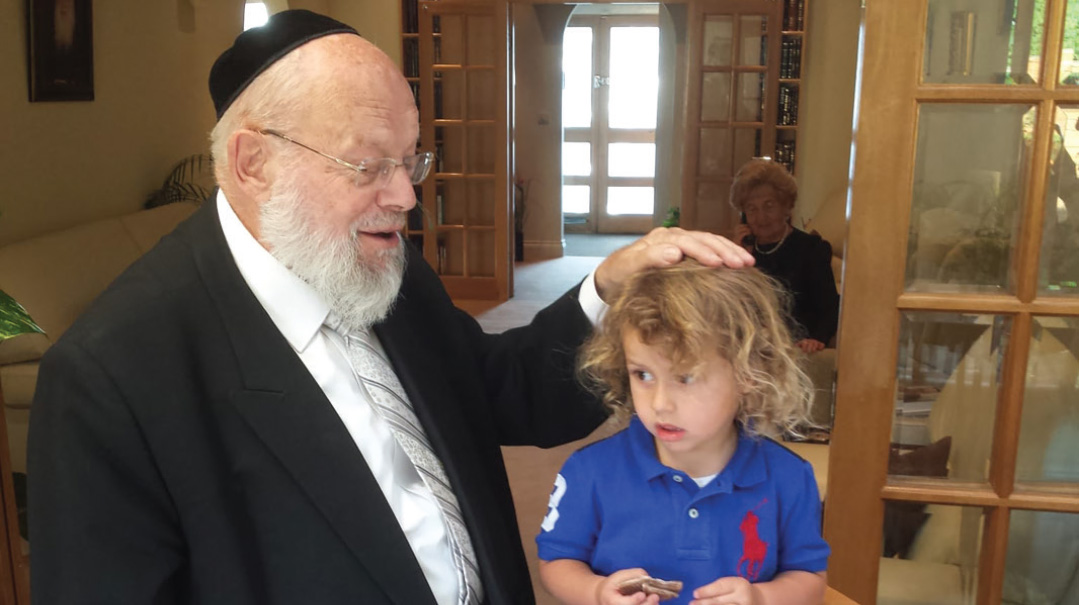
IN the mid-1990s an organization called Limmud began to create a stir among young Jews. Limmud Conferences offered a potpourri of classes from the perspective of all the so-called “streams” or “branches” of Judaism, among which attendees could pick and choose as they wished. The idea of mixing Reform and Orthodox points of view together was anathema to the Dayan, whose grandfather, after whom he was named, had been the rav of the Austrittgemeinde community in Munich, a breakaway from the Reform-dominated general community. He fought hard (and ultimately successfully) to prevent United Synagogue rabbis from attending Limmud.
But he was determined to create a counterforce strategy as well. At a meeting of United Synagogue rabbis convened to discuss responses to Limmud, Rabbi Yisroel Roll proposed establishing a conference to be called Encounter, which would feature talks by some of the leading Jewish teachers and speakers from England and around the world.
Rabbi Roll had been a close friend of the Ehrentreus’ son Shlomo in Toronto, and Reb Shlomo Ehrentreu had encouraged him to leave his successful legal career in Toronto and pursue rabbinical studies in Israel. When he subsequently was hired as a congregational rabbi in London, he became very close to the Ehrentreus. During his near-decade career with SEED-UK and as a congregational rabbi, Rabbi Roll would eat breakfast with the Ehrentreus two or three times a week after dropping off his children at school. Over breakfast, he would present all his communal dilemmas to the Dayan, and receive his advice. Though Rabbi Roll’s relationship was obviously uniquely close, nurturing young rabbis was very high on the Dayan’s agenda as head of the London Beis Din.
It soon became clear that the Encounter Conference, the first of which took place in 1996, would require a large investment of money to bring in speakers from around the world, hire a venue for the expected crowds, and pay for advertising, and logistics. Naturally, Rabbi Roll turned to Dayan Ehrentreu for assistance, and could never have brought Encounter to fruition without the latter’s fundraising assistance. The Dayan encouraged the balabatim in his shul to contribute, and went from foundation to foundation and to individual donors with Rabbi Roll.
When one potential large donor turned them down flat, Rabbi Roll was crestfallen. But the Dayan was not. Echoing Mordechai’s message to Esther, he told Rabbi Roll, “He’s not zocheh, but salvation will come to the Jews from another place.” And it did.
Aside from helping with the fundraising, Dayan Ehrentreu’s second major contribution to Encounter was to bring all the kiruv groups in the UK — the Ohr Somayach-affiliated Jewish Learning Exchange, Aish-UK, SEED, and United Synagogue rabbis — together to work on the conference. In retrospect, it’s clear that only the Dayan commanded sufficient respect among all groups involved to bring about that unity. The Encounter conferences proved a major success, with events held over a span of 11 years.
In 2006, Dayan Ehrentreu stepped down from his active position and became av beis din emeritus of the London Beis Din. He was succeeded by Dayan Menachem Gelley, the son of his old friend from Gateshead and Sunderland, the late Rav Zachariah Gelley. He was nearly 74 years old then, but retirement, as he once told me, was not in his vocabulary. Indeed, the freedom from his day-to-day duties at the London Beis Din allowed him to engage in myriad new projects, and ushered in what was in many ways the most productive period of his life.
Even with respect to the Beis Din, he did not retire. The other dayanim continued to consult with him as new sh’eilos arose. And though they divided up the various areas of supervision between themselves — kashrus, shechitah, gittin, geirus, and eiruvin — they all recognized that his experience and expertise in all those areas exceeded their own.
Between 2006 and 2020, observes Dayan Shmuel Simons, there was probably not an airport in Europe in which the Dayan didn’t set foot in his capacity as head of the Beis Din of European Rabbis, an institution which he largely established. The beis din traveled to cities throughout Eastern and Western Europe to write and supervise the giving of gittin and to handle geirus. The work on gittin allowed him to work together, on occasion, with his son Rabbi Osher Ehrentreu, who deals with procuring gittin for agunos on behalf of Israel’s Chief Rabbinate.
But the overseas endeavor that absorbed the most of his energies was the renascent Jewish community in Germany under the auspices of the Ronald Lauder Foundation and its director Rabbi Joshua Spinner. “I come whenever they ask,” the Dayan told me.
He served as nasi of the reopened Hildesheimer Rabbinical Academy in Berlin. At a semichah ceremony for newly minted rabbis held in Munich in the new Ohel Yaakov shul in 2009, the Dayan explained how the event represented the closing of a circle for him. In 1920, with the death of Rav Dovid Tzvi Hoffman, dean of the Hildesheimer Rabbinerseminar, his grandfather, Rav Chanoch HaKohen Ehrentreu, was invited to take the helm of the Hildesheimer Seminary in Berlin. But his congregation implored him not to abandon them, and he acquiesced. (The same thing would happen to Dayan Ehrentreu when he announced plans to relocate to Jerusalem: The congregants of the Beis Hamedrash implored him not to leave them.)
“Here I stand,” intoned the Dayan, “in the Ohel Yaakov Synagogue in Munich. The first Ohel Yaakov Synagogue, in which my grandfather of blessed memory served his community, burned to the ground. And now in a beautiful new Ohel Yaakov Synagogue, I finally sign in the name Chanoch Ehrentreu to the ordination certificate of the Rabbinerseminar in Berlin, 89 years after my grandfather and namesake was obligated to decline this honor. I do so, and thus, for me, the circle has closed.”
Nasi of the Rabbinerseminar was not just a title for the Dayan. He administered an oral exam to every candidate for semichah, and he kept abreast of the placement and progress of every graduate.
At a communal ceremony honoring the Dayan following that at the German Foreign Ministry, Mrs. Ita Afanasev, whose husband, Rabbi Shlomo Afanasev supervises the communal kashrus in Berlin and gives a shiur in the Rabbinerseminar, related an event that had taken place 16 years earlier. The new Jewish school in Berlin was heavily pressured by the local Jewish community to accept a boy who was not halachically Jewish, upon the threat of removal of all communal support. The incipient Torah kehillah sent the question to Dayan Ehrentreu. He responded, “Do the right thing. And the Eibeshter will do the right thing.” Those words continue to serve as the kehillah’s guiding, Mrs. Afanasev said. They could also have served as the motto for Dayan Ehrentreu’s entire life.
Closer to home in England, the focus of Dayan Ehrentreu’s energies, outside of his shul, was the formation of a kollel in the Edgware neighborhood of Northwest London. In 2004, the kollel opened with ten avreichim, with Rav Yehudah Baruch Lieberman serving as the rosh kollel.
When I interviewed Dayan Ehrentreu in 2018, I shared that I had recently been in Edgware for the first time and had counted eight or nine minyanim on my way to the local SEED shul on Leil Shabbos. His deep blue eyes twinkled at my description of the neighborhood as he told me, “Twelve years ago, none of that was there.”
The success of the Edgware Kollel only whetted his desire to build more. At that 2018 meeting, the Dayan laid out his plans to open yet another kollel in Borehamwood, a neighborhood adjacent to Edgware. That kollel has now come into existence, with 25 or so avreichim learning in the kollel and living with their families in the community, which has one of, if not the highest, concentration of Jews in Europe, but few shomrei Shabbos. The potential impact of the kollel is enormous, and Rav Lieberman, who exchanged his position as rosh kollel in Edgware for that of rosh kollel in Borehamwood, tells me that he has already seen many fruits from the presence of the kollel and the avreichim in the neighborhood and is confident of its long-range success.
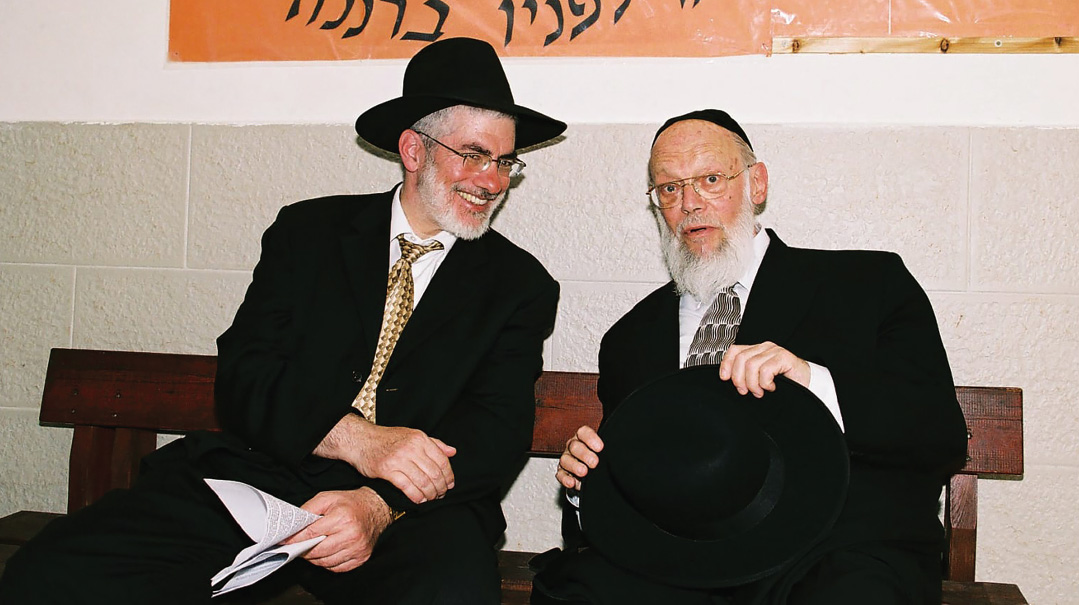
The Dayan with Mishpacha’s Yonoson Rosenblum. He was both a revered rav and a beloved zeide, and not only to his own grandchildren. All the children vied for a chance to sit on his lap
DURING SUKKOS OF 2020, Dayan Ehrentreu suffered a stroke that rendered him unable to speak and greatly impaired the use of his arms. To make matters worse, Covid forced him to remain isolated, without visitors, for a prolonged period.
Suddenly, “harosh hamedabrim b’kol makom — the first among the speakers at any gathering” was unable to speak; someone whose warmth had touched the hearts of everyone he met could communicate only with smiles and limited gestures.
But smile he did. It was almost as if he had taken a vow that no visitor should leave without receiving a smile from him. And his personality remained unchanged. When Rabbi Spinner came to deliver a report on the graduates of the Rabbinerseminar last summer, the Dayan motioned to him, at the end of his presentation, that he wanted to hear about Rabbi Spinner himself. And then he motioned that it was now time for a report on the Spinner daughters. That concern and love for others remained.
He continued to learn as well. Dr. David Landau learned up to daf 119 in Shabbos with him. The ability to learn for hours on end was no longer, but his acuity was still there. “If I said a bad svara, he would motion brusquely to let me know that I was talking rubbish,” says Dr. Landau. And someone davened with him every tefillah. When the person doing so closed the siddur prematurely on Rosh Chodesh Elul, without the Dayan reciting “Mizmor L’David,” the Dayan indicated that he should bring back the siddur that had already been placed on the shelf.
On the morning of the Dayan’s petirah, Suzanne, his gentile caretaker said to the family, “So many people came to see him in order to give him encouragement. But I saw that it was they who always went away strengthened.”
May the memory of his determination to do for the klal and every individual in it, his resolve to build Torah and to guide others in doing so, and the sweetness of his ways, continue to strengthen and inspire each of us.
Yehi zichro baruch
He Wore All the Crowns
By Rabbi Jonathan Guttentag
T
he public response in the UK and beyond to the passing of the Queen was a vivid example of how royalty is mourned. But now we mourn for Torah royalty; Dayan Ehrentreu wore the crowns of Torah, kehunah, and chesed, and in both the Jewish community and the rabbinic world in the UK and beyond, there is a deep sense of aveilus for this tremendous loss.
Sunderland, where I grew up in the 1960s and ’70s, was a Torah citadel, “Sunderland ist vunderland!” the Ponevezher Rav was reputed to say about this outpost of litvisher Torah life. And Rabbi Ehrentreu, father of my childhood friend Shlomy z”l, was a dominant presence. Reb Chanoch, as he was then known, was a man with so much energy and an ever-beaming smile.
The Yamim Tovim of Pesach and Succos were intense highlights for us in the Sunderland Beth Hamedrash shul. The yeshivah and kollel were closed for bein hazmanim, and so Reb Chanoch and the kollel members, together with the roshei yeshivah, would daven together with the balabatim in the Beth Hamedrash Shul.
As a Kohein, Dayan Ehrentreu would duchan each Yom Tov, and I remember his strong and purposeful strides as he would mount the steps in front of the aron kodesh. I can hear his voice ringing out above the others, “L’vareich es amo Yisrael b’ahavaaah.” The full measure of love was in his blessing — it was the life-affirming confidence and love for his fellow man that informed his chesed toward them.
On Simchas Torah, from inside the dancing circle in front of the aron kodesh, his signature set piece in the hakafos would ring forth, his voice issuing a clarion call with strength and passion. “H’aderes v’ha’emunah! Tzu vemen? Tzu vemen? — Majestic strength and faithfulness! To whom?” He demanded an answer from those around him in the dancing circle and they would shout forth their response: “L’chai Ha’olamim! — To the One who lives forever!”
“Habinah v’habrachah! Tzu vemen, tzu vemen? Shrait shoin alle gevaaaaalt! — Discernment and blessing! To whom? To whom?! Everyone scream gevalt!” he would roar in exhortation, his face aglow. He was wreathed in a trademark shining smile, beads of perspiration on his forehead. And the exuberant crowd would burst forth into impassioned song and whirling dance. “Zeh Keili ve’anveihu — This is my G-d and I will glorify Him.”
Rabbi Ehrentreu’s Torah was a Toras chesed. Members of the Sunderland Kollel would testify that each Erev Shabbos he would ensure that every member of the Kollel had been paid and had the wherewithal to make Shabbos for his family. Over the decades, many young couples for whom he served as mohel recounted the excellent after-care he provided, paying house calls to reassure young mothers disconcerted by post-bris bandages.
He excelled at bikur cholim. I recall my own father saying that when our zeidy, his father Gedaliah Dovid Guttentag a”h, was hospitalized before his petirah in 1971, in considerable discomfort, the only visitor from whom he derived some comfort and strength was Reb Chanoch. Shabbos afternoon in the summer in Sunderland there was a six o’clock minyan for Minchah in the Joel Intract Memorial Home of Rest for Aged Jews. Reb Chanoch would daven there, and after Minchah, he would visit the residents and bring them cheer.
When Reb Chanoch duchaned Bircas Kohanim, he stood panim k’neged panim, face to face with the congregation, as halachah demands — a stance that serves as a metaphor for his whole approach to community and which informed the ethos of the institution that he led, the Sunderland Kollel.
When rebbeim were needed to teach the children in Sunderland, and Reb Chanoch instructed the avreichim to close their Gemaras for an hour and to go and teach. When I became a community rabbi in Manchester, the memories of what Reb Chanoch had done for the youth of Sunderland in bringing them inspirational role models and teachers, motivated me to establish the Whitefield Community Kollel along similar lines, where kollel avreichim would be active in the community along similar lines, promoting Torah learning and living.
W
hen we crossed paths again, I was then a young community rabbi, and the energetic Torah dynamo, the Reb Chanoch of my childhood, was now the revered Dayan Ehrentreu. I recall being present at one of the first shiurim that he delivered to London’s United Synagogue rabbanim, in the early 1980s. Dayan Ehrentreu was giving a shiur on a halachic subject connected with Yom Tov, and the chief rabbi at the time, the late Rabbi Jakobovits ztz”l, who had brought him to the position at the London Beth Din, remarked how fitting that choice of topic was — because indeed, whenever Dayan Ehrentreu was around, the gathering took on the air of Yom Tov.
My childhood memories morphed into an adult reality. I recall my mother, Mrs. Eva Guttentag tichyeh, going to his shiurim given to ladies, and coming home deeply impressed. His overall approach was to make it easier, not more difficult, for ladies to keep Torah and mitzvos correctly. That was perhaps an early manifestation of a koach d’heteira that was grounded in an aptitude toward chesed. To those who knew him from those early days, it was no surprise that in later decades, when he rose to the most senior halachic leadership in the UK, he would manifest halachic gevurah in succeeding in establishing the historic first of the UK’s communal eiruvin.
And in the latter stages of his life, the malchus of Dayan Ehrentreu extended across Europe, particularly across Germany, where he helped to foster the rebirth of Torah. I was there in November 2004 at one of the emotional moments of this rebirth. The Beis Zion Shul in East Berlin had last been used as a shul in 1939, and for decades it had served as a warehouse. Sixty-five years later it would be rededicated as the Lauder Yeshiva in Berlin under Rabbi Joshua Spinner.
Speaking at the dedication, Dayan Ehrentreu invoked the passage from Gemara Avodah Zarah, which recounts the famous last words of the great Rabbi Chanina ben Teradyon, as he was martyred at the hands of the Romans for teaching Torah: Gevilin nisrafim, parchments of the Torah scrolls might be burning, but the letters are leaping up into the air.
The JTA reported:
Standing where the bimah had been in Beit Zion, Rabbi Chanoch Ehrentreu of London recalled a terrible scene from his childhood in Frankfurt. “I remember vividly that the Germans took the sifrei Torah,” or Torah scrolls, “from the Beis Hamidrash,” or study house, “and set them alight,” Ehrentreu told the assembled rabbis and guests. “I remember my father saying, ‘You can burn the parchment, but the spirit of the Torah survives.’ ”
Dayan Ehrentreu ztz”l arose from those flames to rebuild the kingdom of Torah in the UK and Europe. He was a truly immortal and irreplaceable royal sage and leader among his people.
Mi yitein lanu temuraso?
Rabbi Jonathan Guttentag is the principal of Whitefield Community Kollel, Manchester, chairman of Eretz Hakodesh UK, chairman of Coalition for Jewish Values International, and member of the Standing Committee of the Conference of European Rabbis.
(Originally featured in Mishpacha, Issue 938)
Oops! We could not locate your form.







